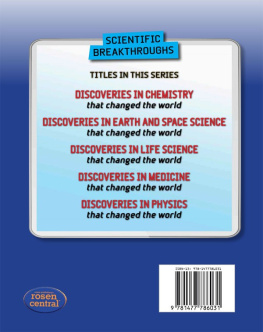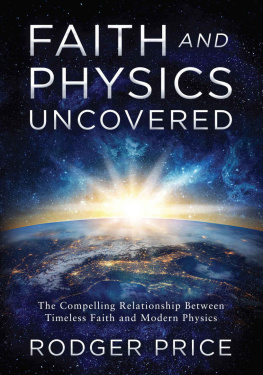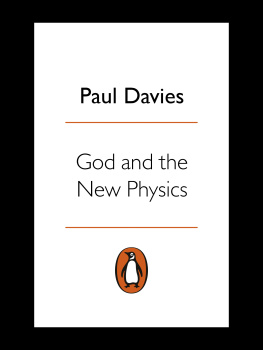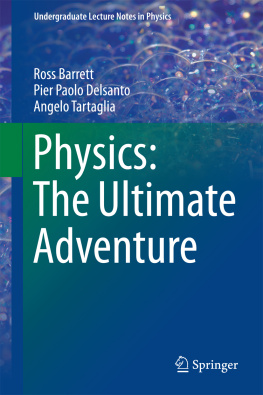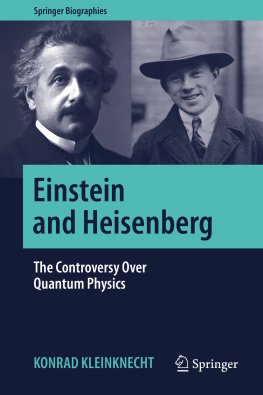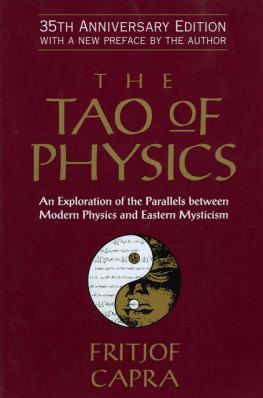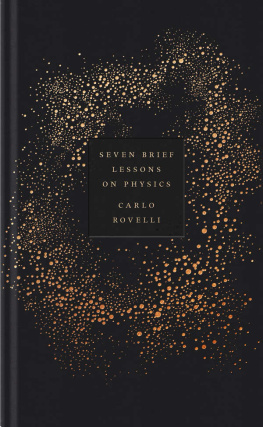Brandt - The harvest of a century: discoveries of modern physics in 100 episodes
Here you can read online Brandt - The harvest of a century: discoveries of modern physics in 100 episodes full text of the book (entire story) in english for free. Download pdf and epub, get meaning, cover and reviews about this ebook. City: Oxford, year: 2013;2009, publisher: Oxford University Press USA - OSO, genre: Art. Description of the work, (preface) as well as reviews are available. Best literature library LitArk.com created for fans of good reading and offers a wide selection of genres:
Romance novel
Science fiction
Adventure
Detective
Science
History
Home and family
Prose
Art
Politics
Computer
Non-fiction
Religion
Business
Children
Humor
Choose a favorite category and find really read worthwhile books. Enjoy immersion in the world of imagination, feel the emotions of the characters or learn something new for yourself, make an fascinating discovery.

The harvest of a century: discoveries of modern physics in 100 episodes: summary, description and annotation
We offer to read an annotation, description, summary or preface (depends on what the author of the book "The harvest of a century: discoveries of modern physics in 100 episodes" wrote himself). If you haven't found the necessary information about the book — write in the comments, we will try to find it.
Brandt: author's other books
Who wrote The harvest of a century: discoveries of modern physics in 100 episodes? Find out the surname, the name of the author of the book and a list of all author's works by series.
The harvest of a century: discoveries of modern physics in 100 episodes — read online for free the complete book (whole text) full work
Below is the text of the book, divided by pages. System saving the place of the last page read, allows you to conveniently read the book "The harvest of a century: discoveries of modern physics in 100 episodes" online for free, without having to search again every time where you left off. Put a bookmark, and you can go to the page where you finished reading at any time.
Font size:
Interval:
Bookmark:
The Harvest of a Century
Discoveries of Modern Physics in 100 Episodes
Siegmund Brandt
Physics Department
University of Siegen


Great Clarendon Street, Oxford OX2 6DP
Oxford University Press is a department of the University of Oxford.
It furthers the Universitys objective of excellence in research, scholarship,
and education by publishing worldwide in
Oxford New York
Auckland Cape Town Dares Salaam Hong Kong Karachi
Kuala Lumpur Madrid Melbourne Mexico City Nairobi
New Delhi Shanghai Taipei Toronto
With offices in
Argentina Austria Brazil Chile Czech Republic France Greece Guatemala Hungary Italy Japan Poland Portugal Singapore South Korea Switzerland Thailand Turkey Ukraine Vietnam
Oxford is a registered trade mark of Oxford University Press
in the UK and in certain other countries
Published in the United States
by Oxford University Press Inc., New York
Siegmund Brandt 2009
The moral rights of the author have been asserted
Database right Oxford University Press (maker)
First Published 2009
All rights reserved. No part of this publication may be reproduced, stored in a retrieval system, or transmitted, in any form or by any means, without the prior permission in writing of Oxford University Press, or as expressly permitted by law, or under terms agreed with the appropriate reprographics rights organization. Enquiries concerning reproduction outside the scope of the above should be sent to the Rights Department, Oxford University Press, at the address above
You must not circulate this book in any other binding or cover
and you must impose the same condition on any acquirer
British Library Cataloguing in Publication Data
Data available
Library of Congress Cataloging in Publication Data
Data available
Printed in Great Britain
on acid-free paper by
CPI Antony Rowe, Chippenham, Wilts
ISBN: 9780199544691
10 9 8 7 6 5 4 3 2 1
To Martin
The intention of this book is to give an impression of the advances of physics in the twentieth century by retracing important discoveries. In this period physicists focussed their interest primarily on two topics, the microscopic structure of matter and the structure of space and time. Sometimes an exact date is attributed to the beginning of modern physics, 14 December 1900, when Planck presented his radiation law, featuring the quantum of action. Half a century later Einstein stated that this discovery [of the quantum of action] became the basis of all twentieth-century physics and has almost entirely conditioned its development ever since. That is still true, now that the whole century has passed. In spite of this, our tale begins a little earlier with important experimental discoveries, those of X rays and the electron, and those of radioactivity, radium, and alpha, beta, and gamma rays before we touch on Plancks work.
The book is conceived as a string of a hundred episodes, covering both experimental and theoretical physics. This structure is meant to allow readers to follow their own particular interests, picking topics of their choice. Still, episodes are arranged in chronological order and readers with no or little previous knowledge in modern physics may want to follow that order, since they will become familiar with the development of the field and its concepts as they go along. Each episode is a short story of the scientists involved, their time, and their work; each is self-contained, with references to others where required. The text is intended for easy reading. Occasionally, a more thorough discussion of experimental set-ups and theoretical concepts is presented in special boxes for readers interested in more detail.
In contrast to science itself, history of science is not well ordered; it develops in twists and turns with ramifications and blind alleys. In our collection of episodes, which can be seen as a mosaic with wide spaces between its stones, many historical details are left unmentioned. The year, given in the title of each episode, is that in which the corresponding discovery was made public, usually by submission of a paper to a learned journal. Often, it took quite some time until discoveries were generally accepted. This, in particular, holds for new theories like Plancks or Einsteins. Again, we scarcely dwell on the reception of the discoveries we describe.
The selection of topics is, of course, to some extent arbitrary. On the other hand, many of those chosen definitely had to be included. It is sincerely hoped that every reader will find at least half of her or his own favourite hundred. The episodes refer to atomic, nuclear, and particle physics, to physics of condensed matter, to relativity, and to physical properties of the universe.
An important starting point for atomic physics was the development of optical spectroscopy in the nineteenth century. Spectroscopic measurements became the basis of Plancks work; when the electron and the nucleus had been found, they allowed the construction and the refinement of atomic models. The culmination point was the formulation of quantum mechanics in the 1920s, a theory which, in extended form, seems to govern all microscopic physics.
Nuclear physics began with the discovery of radioactivity which provided projectiles of rather high energy for scattering and collision experiments. In the early 1930s higher energies, reached by accelerators, and neutrons as new projectiles brought this field to the foreground. A peak was reached with the discovery of nuclear fission and the construction of nuclear reactors in the late 1930s and the 1940s, respectively. Nuclear physics experiments gradually made it clear that there were two additional forces in nature besides the gravitational force (which binds planets to a star) and the electromagnetic force (which binds electrons to a nucleus). These new forces were called strong and weak, respectively. The strong force was needed to keep the nucleus together, the weak one to explain a particular type of its decay. Nuclear physics brought some progress in the understanding of the weak force but no lasting success with the strong.
Particle physics is an off-spring of nuclear physics. It makes use of the very high energies provided by cosmic radiation and modern accelerators and studies collisions of particles simpler than nuclei (except for the proton, the simplest nucleus). Such experiments led to the discovery of many new particles coupled to the strong force (hadrons) and of a few showing only weak and, at most, electromagnetic interactions (leptons). In the 1960s it was found, that hadrons are composed of more fundamental particles, called quarks, and later on that there are as many quarks as there are leptons. On the basis of quarks and leptons, successful theories of the strong and the weak interaction were developed (the latter even was unified with the electromagnetic one) and confirmed by experiment.
From the diversified field of condensed matter physics, episodes are presented on unusual and unexpected phenomena such as superconductivity, superfluidity, and the quantum Hall effects, all understood later on the basis of quantum mechanics. But quantum mechanics also helped to design novel materials and devices. In that context we describe the development of the band model of semiconductors and the construction of transistors and semiconductor laser diodes.
Next pageFont size:
Interval:
Bookmark:
Similar books «The harvest of a century: discoveries of modern physics in 100 episodes»
Look at similar books to The harvest of a century: discoveries of modern physics in 100 episodes. We have selected literature similar in name and meaning in the hope of providing readers with more options to find new, interesting, not yet read works.
Discussion, reviews of the book The harvest of a century: discoveries of modern physics in 100 episodes and just readers' own opinions. Leave your comments, write what you think about the work, its meaning or the main characters. Specify what exactly you liked and what you didn't like, and why you think so.


